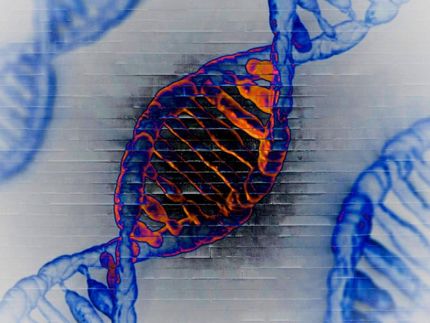A new look at how genes unfold to enable their expression
Cornell researchers have uncovered surprising new information about the process by which genes are unwrapped and exposed so that they can be expressed.
There are 3 billion base pairs of DNA in the human genome, stored in compacted structures in order to fit into the nucleus of a cell. The DNA strands wrap twice around central histone proteins, like rope wrapped around a spool, to create packets called nucleosomes, which then assemble into larger and still more compact structures. When a cell needs a particular protein, the code for it must be transcribed from a strand of DNA by a large, complex enzyme called RNA polymerase II, which copies the code onto a strand of RNA that carries instructions for the cell to produce the protein. To allow this, the nucleosomes disassemble, exposing the part of the DNA strand that is to be copied.
Scientists have long suspected that RNA polymerase II itself drives the unwrapping of DNA from its normal tightly packaged state, but a new study published in the July 11 issue of the journal Cell offers a quite different view. It presents evidence that DNA unwinds from its tight packing even before the transcription enzyme makes contact with that DNA and begins to read it. "Somehow a signal independent of the RNA polymerase II opens up the nucleosome," said John Lis, the paper's senior author and the Barbara McClintock Professor of Molecular Biology and Genetics at Cornell.
While this process has been hinted at in previous studies, this is the first study to offer detailed molecular evidence of bound DNA disassembling independent of RNA polymerase II. The researchers suspect that what they have found holds true for many highly activated genes - those that are called upon to manufacture large quantities of proteins.
"The paper is a molecular dissection of a process we have observed with a microscope at lower resolution as puffs," Lis said. "This new mechanism is so rapid that it is rather startling. It's not the way we normally think about how transcription occurs."
"This study is exciting because everyone always believed these changes in nucleosomes were a result of active transcription and this research shows that transcription and disassembly of nucleosomes can be uncoupled from each other," added Steven Petesch, the paper's lead author and a graduate student in Lis' lab.
Petesch and Lis used heat shock genes from fruit flies as a model system. Heat shock genes are present in many organisms and become activated when temperatures rise above a threshold, as with fevers in humans and on a hot day for fruit flies. These genes activate processes that protect cells from damage, and even play a role in cancer. Researchers can turn on transcription of these genes in seconds by heating. When it is turned on, all the cells in a sample respond together, making it easy to watch processes unfold.
After applying heat, the researchers chemically froze the transcription process at a series of times separated by seconds, and at each stage probed the sample with an enzyme that cuts DNA that is not assembled into a nucleosome. This allowed them to track when and where the unpacking of nucleosomes occurred, and they found that the unpacking occurred well in advance of the arrival of the transcription enzyme.
Additionally, by studying which sections of DNA were cut during their experiment, they found that "This unpacking of nucleosomes is limited by distinct barriers, which protect neighboring genes that lie beyond these barriers," said Lis. This limits the disruption of nucleosomes to only a short section of the DNA around the gene that needs to be expressed.
"We've only tested this at heat shock genes," said Petesch. "But we wouldn't be surprised if it is used by other genes."
Topics
Organizations
Other news from the department science

Get the life science industry in your inbox
By submitting this form you agree that LUMITOS AG will send you the newsletter(s) selected above by email. Your data will not be passed on to third parties. Your data will be stored and processed in accordance with our data protection regulations. LUMITOS may contact you by email for the purpose of advertising or market and opinion surveys. You can revoke your consent at any time without giving reasons to LUMITOS AG, Ernst-Augustin-Str. 2, 12489 Berlin, Germany or by e-mail at revoke@lumitos.com with effect for the future. In addition, each email contains a link to unsubscribe from the corresponding newsletter.
More news from our other portals
Last viewed contents
Herpesviridae
Caliper Life Sciences and Promega Introduce Validated Automation Protocols for Caliper's Sciclone Liquid Handling Workstations

Lambda Laboratory Instruments - Zürich, Switzerland






















































